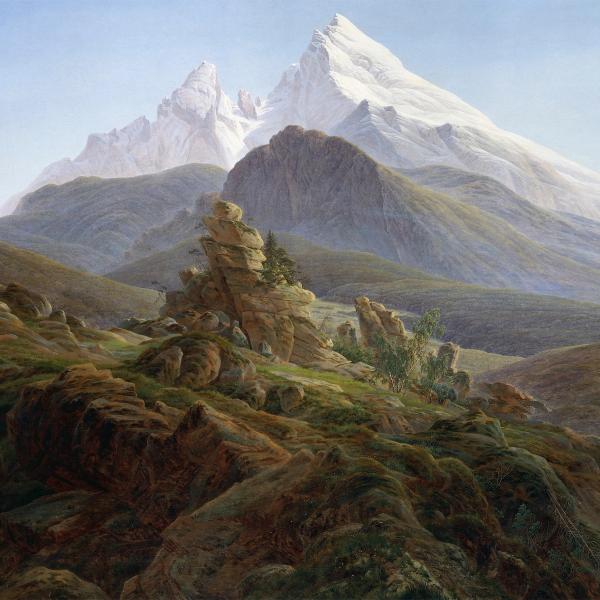The Watzmann
Artwork Details
- Title: The Watzmann
- Artist: Caspar David Friedrich (German, Greifswald 1774–1840 Dresden)
- Date: 1824-25
- Medium: Oil on canvas
- Dimensions: 53 1/8 × 66 15/16 in. (135 × 170 cm)
Framed: 61 7/16 in. × 76 in. × 4 15/16 in. (156 × 193 × 12.5 cm) - Classification: Paintings
- Credit Line: Nationalgalerie, Staaliche Museen zu Berlin; loaned by Deka, Frankfurt am Main (F. V. 317)
- Curatorial Department: European Paintings
Audio

377. Mountain Time (The Watzmann, 1824–25)
Learn why mountains fascinated the Romantics.
ALISON HOKANSON: This particular moment in the Romantic era, people begin to seek out the experience of mountains in a way that they didn’t before.
NARRATOR: Co-curator, Alison Hokanson.
HOKANSON: Mountain climbing, mountain tourism, and images of mountains become desirable on a large scale that they hadn’t previously across Europe.
Friedrich taps into that market in a number of paintings that he makes around the decade of the 1820s.
NARRATOR: In the work before you, The Watzmann, Friedrich paints from an imagined vantage point—he himself never visited this mountain. Instead, he likely worked from images made by other artists who had traveled to the Alps.
HOKANSON: And this is tied in with the sublime, that people suddenly want to have this experience of things that are forbidden, or seem somehow inhuman or terrifying, or uncongenial, and that becomes desirable.
KIM STANLEY ROBINSON: The sublime, it’s a combination of beauty and terror.
NARRATOR: Science fiction author and avid backpacker, Kim Stanley Robinson.
ROBINSON: This combination of beauty and terror is very real in the world, very hard to convey in works of art.
HOKANSON: It’s an experience in nature that produces in you a sense of awe and a sense of wonder, but also of very proximate terror. You’ve come into contact with something much larger than yourself.
ROBINSON: To get at what the sublime feels like in life, for me, I often talk about going to the edge of Yosemite Falls at the top, they’ve got a railing there now. When John Muir stepped out into the shallows to look over the edge, he could easily have been swept off to his death. But now you walk up to a railing, you can hold onto it. And I was gripping it, like, with talon grips out of fear because you’re looking down about 2000 feet to the Yosemite Valley floor and it's very clear that if you fell, you would die.
The scene was beautiful. It was also terrifying.
HOKANSON: This discovery of the mountains, embrace of the mountains, coincides with new developments in the field of geology and the study of the Earth and the Earth’s crust. That the Earth is immeasurably old, way beyond the span of a human life or human memory. And that huge formations like mountains have been formed over these vast periods of time.
ROBINSON: One aspect of sublimity is you feel like a speck. So, suddenly the universe is there and it's huge and it's really vast beyond human comprehension, and it doesn't care about you. And that there you are in it and it’s supporting you. It’s the ground underfoot, and it’s the air that you breathe.
So, this contrast between the individual consciousness and this unimaginable immensity that is the universe itself…. Certain places like out on the ocean, or on a high mountaintop, or in the desert. Places where you suddenly can feel it, then that I think is a touch of the sublime.
###
Music: 4 Impromptus, Op. 90, D. 899: No. 3 in G-Flat Major: Andante, performed by Constantin Stephan (piano) is licensed under CC-BY-3.0